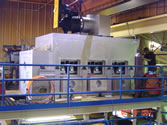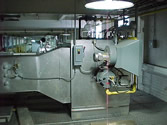Log in
Cire Technologies Blog
Principles of Direct Impingement Dryer Design Series – Paper No. 4 of 8
Calculating the Product Load
The product load is determined by totaling the energy needed to heat up the various constituents of the product to their dryer exiting temperature. These include the web substrate, the coating solids and the coating solution liquid. In order to perform this calculation we need to know the width of the web, the speed of the web, the laydown rate of the coating and the make-up of the coating solids and solution liquid including the percent by weight of each in the coating. From this information we can calculate the pounds per hour processed of each component per hour.
The calculation of the product load for both the solids and the substrate are straight forward:
Product Load(substrate or solids) (btu/hr)=lbs/hr x sp ht x (Texit-Tentry)
Where: lbs/hr = The production rate of the coating solids or web
Sp ht = The specific heat of the coating solids or web in Btu/(lbm·°F)
Texit = The temperature of the solid or web leaving the dryer
Tentry = The temperature of the coating solution or web entering the dryer
The calculation of the product load
for the liquid of the coating solution is a combination of both the specific heat and the latent heat of vaporization of the liquid.
Product Load(coating solution liquid) (Btu/hr)=lbs/hr x (latent ht+sp ht x (Tvaporization-Tentry)
Where: Latent ht = The latent heat of the coating solution liquid
Tvaporization = Boiling point of the liquid
Totaling the product loads for the web substrate, coating solids and coating liquids will provide the total product load that the dryer must handle per hour. Depending on what level of heat transfer the web and coating will handle and what supply air temperature can be tolerated, the length of dryer can vary substantially. As an example the following two cases yield substantially different dryer lengths despite having the same product load.
Total Product Load = 100,000 Btu/hr
Dryer Width = 5 ft
Dryer Supply Air Temperature = 250°F
Web/coating Temperature during Constant Rate of Evaporation = 125°F
Case 1 allowable heat transfer rate = 15 Btu/(hr·ft2·°F)
Case 2 allowable heat transfer rate = 5 Btu/(hr·ft2·°F)
Case 1:
Dryer area=Product Load÷H(∆T)
Dryer length=(dryer area)/(dryer width)=100,000 Btu/hr÷{15 Btu/(hr∙℉∙ft2)x(250℉-125℉)}÷5ft=11 ft
Case 2:
Dryer area=Product Load÷H(∆T)
Dryer length=(dryer area)/(dryer width)=100,000 Btu/hr÷{5 Btu/((hr∙℉∙ft2)x(250℉-125℉)}÷5ft=32 ft
In our next paper we will discuss the dryer design layout variables that affect the heat transfer coefficient of impingement dryers.
When you subscribe to the blog, we will send you an e-mail when there are new updates on the site so you wouldn't miss them.





Comments